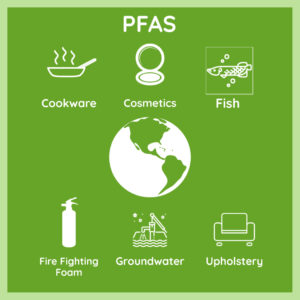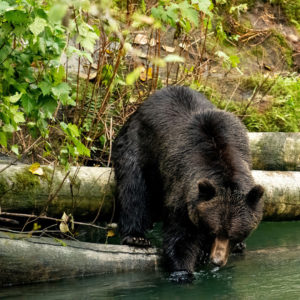The Ecological Impact of Forever Chemicals
PFAS – Per and Polyfluoroalkyl Substances are an environmental threat, especially to ecosystems that provide a stable, balanced environment for wildlife.
They are called forever chemicals.
Forever on the earth.
Forever in existence.
98% of us have them in our blood. Forever.
 There are hundreds of different kinds of PFAS manufactured in various industries worldwide. Cosmetics, chemical-laced food packaging, stain-fighting upholstery, non-stick pots and pans, fire-fighting foam, and consumer products that resist water and grease contain PFAS.
There are hundreds of different kinds of PFAS manufactured in various industries worldwide. Cosmetics, chemical-laced food packaging, stain-fighting upholstery, non-stick pots and pans, fire-fighting foam, and consumer products that resist water and grease contain PFAS.
People who reside near industrial manufacturing plants, airports, or military bases are at greater risk of exposure. In these areas, drinking water may be contaminated, and outdoor air quality may not be so clean. But PFAS exposure is not limited to these areas alone. Daily, humans consume food from chemical-laced food packaging or drink water affected by the spread of chemicals. And so do animals.
Why is this particular group of chemicals so desirable to manufacturers? In a short video, researcher Dr. Rainer Lohmann explains that the PFAS molecules contain hydrophilic and hydrophobic components that help them repel or associate themselves with water. These unique properties make PFAS desirable in producing stain-resistant clothing, fire fighting foam, and upholstery.
 Dr. Rainer Lohmann explains that part of the makeup of the molecules makes them grease-resistant. This quality makes PFAS desirable in food packagings like pizza boxes or microwaveable popcorn bag lining. Packaging is one way, according to Dr. Lohmann, that PFAS enter into human food sources.
Dr. Rainer Lohmann explains that part of the makeup of the molecules makes them grease-resistant. This quality makes PFAS desirable in food packagings like pizza boxes or microwaveable popcorn bag lining. Packaging is one way, according to Dr. Lohmann, that PFAS enter into human food sources.
The production of PFAS has slowed down, and many companies are slowly finding alternative substances; however, significant concern remains.
If human health is in jeopardy, how do “forever chemicals” impact ecosystems across the globe?
Oceans, Land, and Sky
Chemicals that do not break down in the environment negatively impact ecosystems across the globe.
To say that ecosystems are affected by PFAS is an understatement. If by affected, we mean to say reproductive harm, ecological destruction, and deadly to living organisms, then certainly “affected” is an accurate term.
But the wildlife that relies on balanced ecosystems would probably be disheartened to learn that PFAS exposure is only now recognized as a significant environmental issue. As scientists embark on unchartered chemical territory, the calls to end the production of PFAS get louder.
 The impact of PFAS on ecosystems has scholars’ attention around the world. Anna Robuck, Ph.D. Candidate at the University of Rhode Island Graduate School of Oceanography is concerned. Robuck uses various methods to screen birds from different coastal environments. Her research identifies the potential for PFAS bioaccumulation across the estuarine/marine continuum.
The impact of PFAS on ecosystems has scholars’ attention around the world. Anna Robuck, Ph.D. Candidate at the University of Rhode Island Graduate School of Oceanography is concerned. Robuck uses various methods to screen birds from different coastal environments. Her research identifies the potential for PFAS bioaccumulation across the estuarine/marine continuum.
And there is a reason for concern.
Robuck explains that “Birds are dependent on fat stores to be able to make long migrations that are part of their life cycle, and increasingly, we are seeing migratory failures. Are PFAS causing this? We don’t know yet,” says Robuck, “but the trend is reason enough for much more continued study.”
Robuck says, “There’s another trend as well – “no reproduction zones.” “…there are places in waterways, often near chemical plants, where fish and other creatures just don’t breed anymore.”
The threat to wildlife is not limited to one area of the world. A growing body of research suggests that the chemicals travel from soil to freshwater and eventually end up in oceans as far as the arctic.
The results of many studies show that animals may suffer from reproductive abnormalities, failed liver function, and weakened immune systems.
Who is responsible for stopping the spread?
 Humans have the immense responsibility to protect healthy ecosystems beginning with the smallest living organism. There needs to be a unified response to preserve the wildlife dependent on sustainable, balanced ecosystems.
Humans have the immense responsibility to protect healthy ecosystems beginning with the smallest living organism. There needs to be a unified response to preserve the wildlife dependent on sustainable, balanced ecosystems.
Our charge is to steward the earth, yet it seems as though we are faltering in this realm. We must do better.
AMD Environmental Consultants is directing its efforts toward testing and removing PFAS in drinking water. The AMD team collaborates with other environmental testing professionals in a combined effort to identify and deal with PFAS.
Our environmental services are available for testing in industrial, commercial, and residential structures.
Together, we can make a difference.

